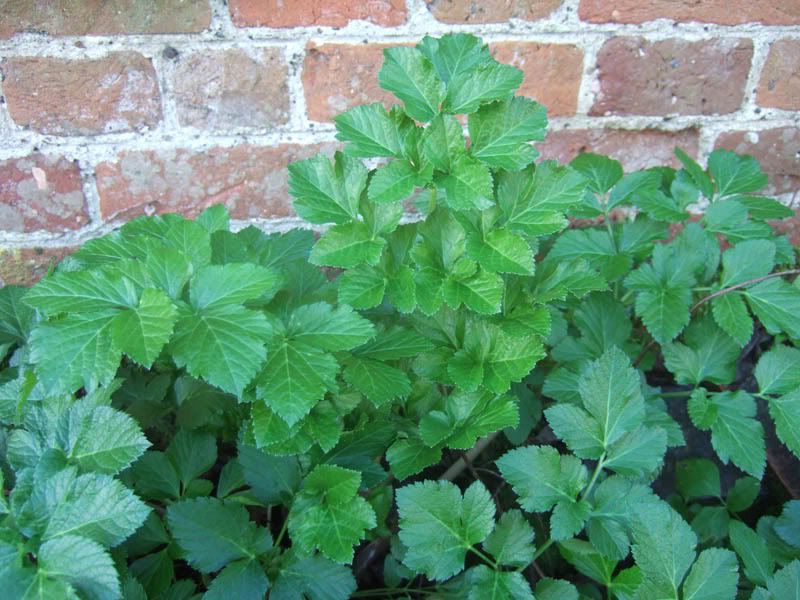
Sheltered against the garden wall is a patch of the greeniest green leaves - almost luminous in intensity, they glow green! They are the leaves of Alexanders, smyrnium olusatrum - if your botanical latin (greek?) is pretty hot then you will have already worked out that it's a culinary herb that smells of myrrh and has black seeds. The English name Alexanders gives us another clue - it originates from Alexandria, or thereabouts, and was brought to England by the Romans. Whether they actually brought along neat little packages of seed to sow in their newly built villa's vegetable plots, or the seeds just got stuck to the soles of the centurian's sandals isn't clear, but apparently until celery was introduced a couple of hundred years ago, Alexanders was the herb of choice to pep up your potage!
Alexanders grows in profusion along the country lanes of North Norfolk, a few years ago while walking along the coastal footpath I picked a few black seeds from the plants growing near the site of Branodunum and planted them on the edge of our vegetable garden. I've read that the Roman fort of Branodunum was manned by cavalry troups from Dalmatia (or as we know it, Croatia) – maybe Alexanders was a key ingredient in their favourite soup! Today the sight of the glowing fresh green leaves against the red brick wall persuaded me to pick a couple of tender, newly emerged leaves and use them to flavour an omelette for lunch. They smelt like a strong earthy celery with a pungency that's hard to pin down. Chopped and cooked in the omelette the flecks of bright green looked brighter than parsley – promising! I rolled the omelette, cut it in slices and put it in a warm pitta bread with lettuce and a smear of houmous, I couldn't taste the Alexanders while I was munching my lunch. Then I got the after-taste! A bitter, deep earthy undertone of herbiness, don't under-estimate the ancient great uncle of celery - go easy with Alexanders!
I understand the best part is the young flower stalk which is peeled and cooked like asparagus, maybe the stalks will be kinder on the tastebuds. They still deserve their place in the garden, not just for having the greeniest green leaves, but for their beautiful pale green honey fragrant flowers which will attract all kinds of beneficial insects to the garden.






Celia,
ReplyDeleteI once grew this - I didn't use much of it because of the bitter taste. My neighbour loved it and took most all of it.
Yes, the flower stem is much nicer! It should be young and "sappy" though. Try it with crusty bread and ham-off-the-bone and in scrambled eggs.A "hippy" chap in Hampstead used to put chopped Alexander stems into his casseroles, but I think he'd pretty much killed his taste buds with all sorts of smoke!
ReplyDeleteFascinating post-I have never come across this plant at all before.
ReplyDeleteThanks, Celia! I've read about alexanders but have never known anyone who grew them.
ReplyDeleteWhat a delightful post. I must try growing this in the garden as it sounds great. I could almost smell your omelette.
ReplyDeleteThanks
Kate - the bitterness of the leaves is very strong!
ReplyDeleteDinahmow - I'll try the flower stems when they've grown. I really wnat to like this plant.
Threadspider - Alexanders is common along the East Anglian coast and inland along the ancient trackways.
Val - it's not common to grow Alexanders in a garden, but it's a good plant to attract insects.
CS - you're sure to find some Alexanders along the country lanes - grab a few black seeds later in the summer.